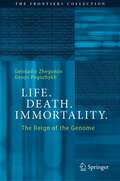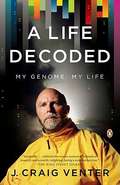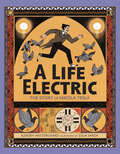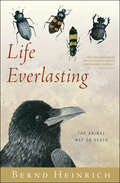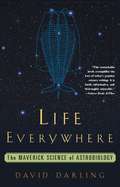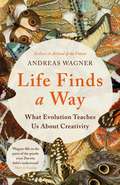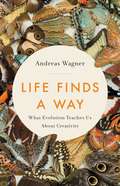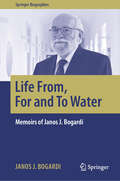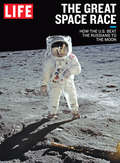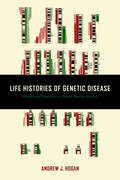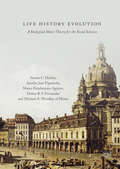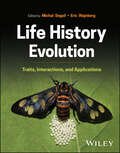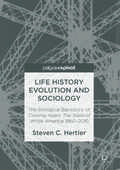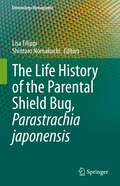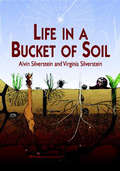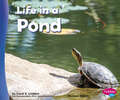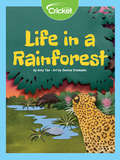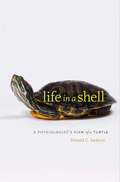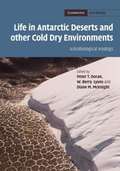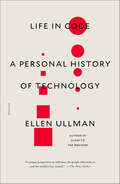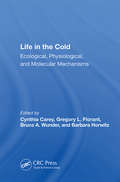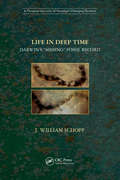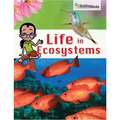- Table View
- List View
Life. Death. Immortality.: The Reign of the Genome (The Frontiers Collection)
by Gennadiy Zhegunov Denys PogozhykhWhat are life and death? Is it possible to understand their essence and give clear definitions? Countless books and articles have been devoted to trying to answer these intriguing questions. However, there are still no definite and generally accepted answers. The intrigue remains. And meanwhile, human attempts to vanquish death and achieve immortality continue apace.This book is an attempt to answer the eternal questions about life and death by analyzing, synthesizing, and rethinking the known facts that characterize life. The material here should be of particular interest, as it contains many hypotheses, philosophical generalizations, and well informed speculations. What is most important for life - matter, energy, or information? How are individual lives and the phenomenon of life in general related? What serves what – does the genome serve the cell or does the cell serve the genome? What is the value of life and death? Can we become immortal? The inquisitive reader will find original answers to these and other exciting questions in the pages of this stimulating book.
A Life Decoded: My Genome: My Life
by J. Craig VenterThe triumphant memoir of the man behind one of the greatest feats in scientific historyOf all the scientific achievements of the past century, perhaps none can match the deciphering of the human genetic code, both for its technical brilliance and for its implications for our future. In A Life Decoded, J. Craig Venter traces his rise from an uninspired student to one of the most fascinating and controversial figures in science today. Here, Venter relates the unparalleled drama of the quest to decode the human genome-a goal he predicted he could achieve years earlier and more cheaply than the government-sponsored Human Genome Project, and one that he fulfilled in 2001. A thrilling story of detection, A Life Decoded is also a revealing, and often troubling, look at how science is practiced today.
A Life Electric: The Story of Nikola Tesla
by Azadeh WestergaardA lyrical biography of the eccentric engineer and inventor Nikola Tesla &“An elegant and enlightening look at a man who brightened the whole world.&” –Booklist, starred reviewBorn at the stroke of midnight during a lightning storm, Nikola Tesla grew up to become one of the most important electrical inventors in the world. But before working with electricity, he was a child who loved playing with the animals on his family's farm in Serbia. An inventor since childhood, Tesla's patents encompassed everything from radar and remote-control technology to wireless communications. But his greatest invention was the AC induction motor, which used alternating currents ( AC) to distribute electricity and which remains the standard for electric distribution today. Tesla's love of animals also remained constant throughout his life and led to his anointment as the Pigeon Charmer of New York for his devotion to nature's original wireless messengers.Exploring his groundbreaking inventions against the backdrop of his private life, A Life Electric introduces Nikola Tesla to young readers unlike ever before. Azadeh Westergaard's lyrical debut brings compassion and humanity to the legacy of the brilliant inventor, while the esteemed illustrator Júlia Sardà deftly brings him to life.
Life Everlasting: The Animal Way of Death
by Bernd HeinrichAn enlightening look at animal behavior and the cycle of life and death, from &“one of the finest naturalists of our time&” (Edward O. Wilson). When a good friend with a severe illness wrote, asking if he might have his &“green burial&” at Bernd Heinrich&’s hunting camp in Maine, it inspired the acclaimed biologist to investigate a subject that had long fascinated him. How exactly does the animal world deal with the flip side of the life cycle? And what are the lessons, ecological to spiritual, imparted by a close look at how the animal world renews itself? Heinrich focuses his wholly original gaze on the fascinating doings of creatures most of us would otherwise turn away from—field mouse burials conducted by carrion beetles; the communication strategies of ravens, &“the premier northern undertakers&”; and the &“inadvertent teamwork&” among wolves and large cats, foxes and weasels, bald eagles and nuthatches in cold-weather dispersal of prey. Heinrich reveals, too, how and where humans still play our ancient and important role as scavengers, thereby turning not dust to dust, but life to life. &“If it has not been clear to readers by now, this book confirms that Bernd Heinrich is one of the finest naturalists of our time. Life Everlasting shines with the authenticity and originality that are unique to a life devoted to natural history in the field.&” —Edward O. Wilson, author of The Meaning of Human Existence and The Social Conquest of Earth
Life Everywhere
by David DarlingTo many people, the main question about extraterrestrial life is whether it exists. But to the scientific community, that question has already been answered: it does, and within our solar system. The new science of astrobiology is already being practiced at NASA's Astrobiology Institute and the University of Washington's new Department of Astrobiology. Life Everywhere is the first book to lay out what the new science of astrobiology is all about. It asks the fascinating questions researchers in astrobiology are asking themselves: What is life? How does it originate? How often does life survive once it arises? How does evolution work? And what determines whether complex or intelligent life will emerge from more primitive forms? Informed by interviews with most of the top people in this nascent field, this book introduces readers to one of the most important scientific developments of the next century.
Life Finds a Way: What Evolution Teaches Us About Creativity
by Andreas Wagner&‘This is a wonderful, mind-expanding book. Prepare to be surprised, enlightened and awed as Wagner reveals the sources of human and natural creativity.&’ – Alice RobertsIn Darwin&’s survival of the fittest, each step must be uphill as life progresses towards an evolutionary peak. There is no turning back. So what happens when life needs to cross a valley in the wilds of an adaptive landscape to reach the highest summit? World-renowned biologist Andreas Wagner reveals that life does not only walk – it also leaps. Drawing on pioneering research, Wagner explores life&’s creative process and how it bears a striking resemblance to how we humans work. A beguiling symmetry links Picasso struggling through forty versions of Guernica and the way evolution transformed a dinosaur&’s claw into a condor&’s wing. This new understanding is already revolutionising our approach to problem-solving across the sciences. In the near future, applied in spheres as diverse as the economy and education, it will enable us to do so much more. Life Finds a Way is a thought-provoking and deeply hopeful look at the force that shapes our world.
Life Finds a Way: What Evolution Teaches Us About Creativity
by Andreas WagnerHow the principles of biological innovation can help us overcome creative challenges in art, business, and scienceIn Life Finds a Way, biologist Andreas Wagner reveals the deep symmetry between innovation in biological evolution and human cultural creativity. Rarely is either a linear climb to perfection--instead, "progress" is typically marked by a sequence of peaks, plateaus, and pitfalls. For instance, in Picasso's forty-some iterations of Guernica, we see the same combination of small steps, incessant reshuffling, and large, almost reckless, leaps that characterize the way evolution transformed a dinosaur's grasping claw into a condor's soaring wing. By understanding these principles, we can also better realize our own creative potential to find new solutions to adversity.Ultimately, Life Finds a Way offers a new framework for the nature of creativity, enabling us to better adapt, grow, and change in art, business, or science--that is, in life.
Life From, For and To Water: Memoirs of Janos J. Bogardi (Springer Biographies)
by Janos J. BogardiThis book is translated from Hungarian. It was originally published as the sixth volume of the "Building the Future in Water Resources Management" series of the Water Science Council of the Hungarian Water Resources Management Directorate. It presents the water resources management of the last 50 plus years as seen, experienced, co-shaped and narrated by Janos Bogardi, a research professor of the Ludovika University of Public Service in Budapest. The author is simultaneously co-opted professor at the University of Bonn and distinguished adjunct professor of the Asian Institute of Technology, Pathumthani, Thailand. Born into a water resources engineering family and growing up in Budapest close to the Danube river pre-determined his professional orientation. He describes with light irony, and without the usual memoir style, his search for a fulfilling professional life. He discusses his engagement with the inter-university cooperation helping the transition of Central European universities earning him numerous academic recognitions. Dr. Bogardi’s career culminated with assignments as science diplomat and manager, working at UNESCO with local scientists in Central Asia, Russia and in Africa. He served as founding director of the UNU Institute for Environment and Human Security. The book concludes with reminiscences to those whose influence and collaboration shaped Dr. Bogardi’s career.
LIFE The Great Space Race: How the U.S. Beat the Russians to the Moon
by The Editors of LifeForged in the cauldron of both Nazi Germany and the Soviet Gulag-and fueled by the development of nuclear weapons during the Cold War-The Great Space Race is an epic drama filled with triumphs and tragedies, both technological and deeply human, that riveted the U.S. even as it seemed the fate of the free world (perhaps even the world itself ) hung in the balance.The book features rare, exclusive photographs and thrilling reporting, reflecting LIFE's insider access to the astronauts, their families, and their missions: Go behind the scenes as John Glenn trains for his historic flight, and marvel with Joan Aldrin as her husband, "Buzz," becomes the second man to set foot on the lunar surface. Join Anne Morrow Lindbergh and her aviator husband, Charles, as they visit the Apollo 8 crew on the eve of their historic holiday mission. Watch from the top of the rocket launcher as LIFE's photographer captures the launch of the first manned trip to the moon....and much more.
Life Histories of Genetic Disease: Patterns and Prevention in Postwar Medical Genetics
by Andrew J. HoganA history of genetic testing warns that such tests may tell us more than we want to know.Medical geneticists began mapping the chromosomal infrastructure piece by piece in the 1970s by focusing on what was known about individual genetic disorders. Five decades later, their infrastructure had become an edifice for prevention, allowing today’s expecting parents to choose to test prenatally for hundreds of disease-specific mutations using powerful genetic testing platforms. In Life Histories of Genetic Disease, Andrew J. Hogan explores how various diseases were "made genetic" after 1960, with the long-term aim of treating and curing them using gene therapy. In the process, he explains, these disorders were located in the human genome and became targets for prenatal prevention, while the ongoing promise of gene therapy remained on the distant horizon.In narrating the history of research that contributed to diagnostic genetic medicine, Hogan describes the expanding scope of prenatal diagnosis and prevention. He draws on case studies of Prader-Willi, fragile X, DiGeorge, and velo-cardio-facial syndromes to illustrate that almost all testing in medical genetics is inseparable from the larger—and increasingly "big data"–oriented—aims of biomedical research. Hogan also reveals how contemporary genetic testing infrastructure reflects an intense collaboration among cytogeneticists, molecular biologists, and doctors specializing in human malformation.Hogan critiques the modern ideology of genetic prevention, which suggests that all pregnancies are at risk for genetic disease and should be subject to extensive genomic screening. He examines the dilemmas and ethics of the use of prenatal diagnostic information in an era when medical geneticists and biotechnology companies have begun offering whole genome prenatal screening—essentially searching for any disease-causing mutation. Hogan’s focus and analysis is animated by ongoing scientific and scholarly debates about the extent to which the preventive focus in contemporary medical genetics resembles the aims of earlier eugenicists. Written for historians, sociologists, and anthropologists of science and medicine, as well as bioethics scholars, physicians, geneticists, and families affected by genetic conditions, Life Histories of Genetic Disease is a profound exploration of the scientific culture surrounding malformation and mutation.
Life History Evolution: A Biological Meta-Theory for the Social Sciences
by Steven C. Hertler Aurelio José Figueredo Mateo Peñaherrera-Aguirre Heitor B. Fernandes Michael A. Woodley of MenieThe social sciences share a mission to shed light on human nature and society. However, there is no widely accepted meta-theory; no foundation from which variables can be linked, causally sequenced, or ultimately explained. This book advances “life history evolution” as the missing meta-theory for the social sciences. Originally a biological theory for the variation between species, research on life history evolution now encompasses psychological and sociological variation within the human species that has long been the stock and trade of social scientific study. The eighteen chapters of this book review six disciplines, eighteen authors, and eighty-two volumes published between 1734 and 2015—re-reading the texts in the light of life history evolution.
Life History Evolution: Traits, Interactions, and Applications
by Michal Segoli Eric WajnbergProvides a timely and authoritative account of Life History Evolution by a multidisciplinary team of scholars and researchers from around the world Life History Evolution: Traits, Interactions, and Applications presents a cutting-edge synthesis of the mechanisms driving life history strategies that span the breadth of taxa, from bacteria to humans. Integrating classical and contemporary perspectives, this comprehensive volume addresses how organisms evolve traits in response to diverse ecological pressures. Editors Michal Segoli and Eric Wajnberg bring together leading experts to explore the intersection of evolutionary biology, ecology, and applied research, focusing on the evolving complexity of life history traits and their implications. In-depth yet accessible chapters cover a broad spectrum of life history traits, from classical traits of lifespan and reproduction to more complex interactions like social behaviour, predator-prey dynamics, and human-induced evolutionary processes. The contributing authors explain essential concepts, identify critical knowledge gaps, discuss future research directions, and demonstrate the relevance of life history evolution in addressing climate change, species invasion, pollution, and more. Providing a well-balanced understanding of life history traits and their implications, Life History Evolution: Incorporates recent advances in evolutionary theory, including eco-evolutionary feedback loops and anthropogenic impacts Offers diverse perspectives and original research from leading experts in fields such as evolutionary biology, ecology, entomology, zoology, agriculture, and veterinary medicine Discusses life history evolution in the context of co-evolved interactions such as predator-prey, parasite-host, plant-herbivore, and endosymbiont-host relationships Provides an overview of the foundational theory, recent developments, and current thinking in the field Features numerous case studies that highlight real-world applications in biological control, wildlife management, climate change adaptation, and others Revealing how life history traits shape the evolutionary strategies of organisms, Life History Evolution: Traits, Interactions, and Applications is an essential resource for undergraduate and graduate students, researchers, industry professionals, and policymakers in ecological science. It is an ideal textbook for courses in evolutionary ecology, evolutionary biology, conservation biology, environmental science, and environmental management.
Life History Evolution and Sociology
by Steven C. HertlerThis book supplies the evolutionary and genetic framework that Charles Murray, towards the end of Coming Apart: The State of White America 1960-2010, predicts will one day explain revolutionary change in American society. Murray's Coming Apart documents 50 years of changed college admissions, government incentives, mating and migration patterns that have wrought national divisions across indexes of marriage, industriousness, honesty, and religiosity. The framework discussed is life history evolution, a sub-discipline within evolutionary biology singly capable of explaining why violent crime, property crime, low marriage rates, father absence, early birth, low educational achievement, low income, poverty, lack of religiosity and reduced achievement striving will reliably co-occur as part of a complex. This complex augments facultatively, developmentally and evolutionarily in response to unpredictable and uncontrollable sources of mortality. The uncertain tenure of life wrought by unpredictable and uncontrollable mortality selects for a present-oriented use of bioenergetics resources recognizable as the social ills of Fishtown, Murray's archetypal working class community. In turn, the thirty years of life history literature herein reviewed confirms the biological logic of elite intermarriage and sequestration. The source of life history variation, policy implications, and demography are discussed.
The Life History of the Parental Shield Bug, Parastrachia japonensis (Entomology Monographs)
by Lisa Filippi Shintaro NomakuchiThis book presents the discoveries made during nearly three decades of research on the parental shield bug, Parastrachia japonensis inhabiting Kyushu Island, Japan. P. japonensis has evolved a unique and fascinating life history, characterized by extreme behavioral and physiological adaptations that have culminated in a singularly dependent relationship with its lone host tree, Schoepfia jasminodora (Olacaceae), which is a generally scarce and unreliable resource. It is expected that the evolution of parental care behaviors in the strictly semelparous P. japonensis was more directly influenced by the benefit to females that arises from enhanced survivorship of current offspring, rather than any possible cost the females might incur in terms of reduced future reproductive success, because no future reproduction is possible. The authors explain how the different parental cares in this species enhance offspring survivorship in the context of the ecological conditions it has experienced over evolutionary time. The book begins with a recap of the earliest studies, the reports through 1991, and then introduces the many fascinating aspects of the life history, neurobiology, physiology and behavior of P. japonensis that have been newly discovered since, and those aspects that have been confirmed through experimentation over the past thirty years. This comprehensive review of information will be useful for comparative studies of parental care in other semelparous and iteroparous organisms experiencing both similar and different ecological constraints. The book will be of academic interest to undergraduate and graduate students of entomology, zoology, behavior, and behavioral ecology.
Life in a Bucket of Soil (Dover Children's Science Books)
by Alvin Silverstein Virginia SilversteinThe soil in forests, meadows, and fields — even in vacant city lots or your own backyard — swarms with countless tiny creatures, most of which are born, struggle for life, and die just beneath the earth’s surface. In fact, you can find a bountiful sampling of these underground inhabitants simply by filling a bucket with soil. The small animals you’re likely to find are vividly described in this fascinating, easy-to-read book, specially designed to acquaint you with a vast, living world beneath your feet.You’ll learn about tunnel-building earthworms; threadlike, wriggly roundworms; snails and slugs (the “slime gliders”); armored scavengers such as wood lice and centipedes; “flying tanks,” more commonly known as beetles; lurking hunters such as spiders; the busy underground colonies of ants; and numerous other inhabitants of the soil. You’ll find out how these diminutive animals live, breed, and interact; learn about their methods of locomotion, feeding, and defense; and even discover how they affect the soil in which they live. The authors also provide helpful suggestions for collecting specimens and explain how they can be preserved and studied.Illustrated with more than 70 detailed black-and-white drawings, this fact-filled book will introduce you to an amazing subterranean world most people never even think about. It is sure to appeal to young naturalists, junior biologist, insect lovers, and anyone curious about the natural world.
Life in a Rainforest
by Amy TaoDo you know how many animals live in the Amazonian rainforest? Learn about the different predators and prey that coexist and depend on one another to survive in their ecosystem.
Life in a Shell: A Physiologist's View of a Turtle
by Donald C. JacksonTrundling along in essentially the same form for some 220 million years, turtles have seen dinosaurs come and go, mammals emerge, and humankind expand its dominion. Is it any wonder the persistent reptile bested the hare? In this engaging book physiologist Donald Jackson shares a lifetime of observation of this curious creature, allowing us a look under the shell of an animal at once so familiar and so strange. Here we discover how the turtle’s proverbial slowness helps it survive a long, cold winter under ice. How the shell not only serves as a protective home but also influences such essential functions as buoyancy control, breathing, and surviving remarkably long periods without oxygen, and how many other physiological features help define this unique animal. Jackson offers insight into what exactly it’s like to live inside a shell—to carry the heavy carapace on land and in water, to breathe without an expandable ribcage, to have sex with all that body armor intervening. Along the way we also learn something about the process of scientific discovery—how the answer to one question leads to new questions, how a chance observation can change the direction of study, and above all how new research always builds on the previous work of others. A clear and informative exposition of physiological concepts using the turtle as a model organism, the book is as interesting for what it tells us about scientific investigation as it is for its deep and detailed understanding of how the enduring turtle “works.”
Life in Antarctic Deserts and Other Cold Dry Environments
by Peter T. Doran W. Berry Lyons Diane M. Mcknight"The McMurdo Dry Valleys form the largest relatively ice-free area on the Antarctic continent. The perennially ice-covered lakes, ephemeral streams and extensive areas of exposed soil are subject to low temperatures, limited precipitation and salt accumulation. The dry valleys thus represent a region where life approaches its environmental limits. This unique ecosystem has been studied for several decades as an analog to environments on other planets, particularly Mars. For the first time, the detailed terrestrial research of the dry valleys is brought together here, presented from an astrobiological perspective. Chapters include a discussion on the history of research in the valleys, a geological background of the valleys, setting them up as analogs for Mars, followed by chapters on the various sub-environments in the valleys such as lakes, glaciers and soils. Includes concluding chapters on biodiversity and other analog environments on Earth"--Provided by publisher.
Life in Code: A Personal History of Technology
by Ellen UllmanThe never-more-necessary return of one of our most vital and eloquent voices on technology and culture, the author of the seminal Close to the MachineThe last twenty years have brought us the rise of the internet, the development of artificial intelligence, the ubiquity of once unimaginably powerful computers, and the thorough transformation of our economy and society. Through it all, Ellen Ullman lived and worked inside that rising culture of technology, and in Life in Code she tells the continuing story of the changes it wrought with a unique, expert perspective.When Ellen Ullman moved to San Francisco in the early 1970s and went on to become a computer programmer, she was joining a small, idealistic, and almost exclusively male cadre that aspired to genuinely change the world. In 1997 Ullman wrote Close to the Machine, the now classic and still definitive account of life as a coder at the birth of what would be a sweeping technological, cultural, and financial revolution.Twenty years later, the story Ullman recounts is neither one of unbridled triumph nor a nostalgic denial of progress. It is necessarily the story of digital technology’s loss of innocence as it entered the cultural mainstream, and it is a personal reckoning with all that has changed, and so much that hasn’t. Life in Code is an essential text toward our understanding of the last twenty years—and the next twenty.
Life In The Cold: Ecological, Physiological, And Molecular Mechanisms
by Cynthia CareyContributors present the newest information on ecological, physiological, neurological, cellular and biochemical mechanisms by which vertebrates deal with seasonal cold.
Life in Deep Time: Darwin’s “Missing” Fossil Record
by J. William SchopfWhen Darwin wrote his Origin of Species, one of his main concerns was with the perceived shortness of the fossil record of life. Until the work of J. William Schopf and his colleagues, much of this history was thought to be unknowable. This book, through a memoire of Schopf’s personal recollections, documents astonishing discoveries revealing the first 85% of the history of life. These earliest periods of life on Earth emerge as a tale of individual and internationally collaborative exploration told by a scholar whose 60 years of research contributed to the recognition of the richness and diversity which forms the foundation of today’s biodiversity. Key Features Documents, through personal narrative, a paradigm shift is the study of the earliest life Summarizes a fossil record largely unknown until relatively recently Addresses one of Darwin's most troubling concerns about his theory of natural selection Predicts future developments in the study of first life
Life in Ecosystems
by Linda CernakNIMAC-sourced textbook <p><p> Life in Ecosystems introduces students to the diversity of living organisms
Life in Ecosystems
by Linda CernakEcosystems and Habitats, Adaptations: Behavior and Physical, Science and Engineering Practices, Careers.
